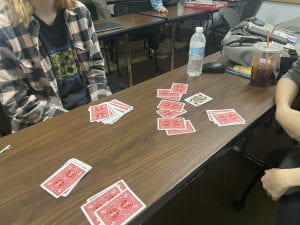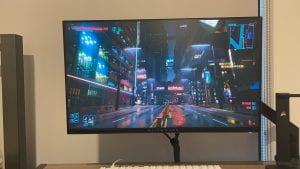Background:
In 1916, exiled Zurich artists such as Hugo Barr, Amy Hennings, Tristan Tzara, Hans Arp, Richard Husenbeck, and Sophie Thorber formed a literary society in the local Hotel Voltaire, where they expressed their distaste for the war and the values that spawned it, through discussions of artistic topics and performances.
Requirements: 4-5 players, Dice
Basic rules
Description: This is a board game that requires 4 players. Each player represents a side, they are Military, Workers, Merchants, and Artists. Each side will have 20 million population. If a player’s population is eliminated that means its side is out of the game. If there is more player, they will automatically be civilian side.
Basic Rules: Roll the dice to decide who to start with, with the order of players after that going clockwise.
There will be four identity cards representing the different powers on the field, and each person draws one at random after it is disrupted face down. After that, you will receive your population, and each player will have a total of 1 card with a population of 10 Million, 1 card with a population of 5 Million, and 5 cards with a population of 1 Million. Players will need to place these population cards face down in random combinations around the identity cards to avoid being seen by other players. Players can trade resources with each other (consensual) or money (players can use money to buy other goods and the person they are trading with can’t refuse), or attack (artists can’t attack).
Warmonger: This is a power ruled by war-mongers who are passionate about selling nuclear weapons or using them to bomb other countries. In the game, warmongers will bring their nuke at the start of their turn, and automatically get one every 3 turns thereafter. Nukes can be traded and used to attack other countries, but only once every two turns. Nukes can be traded and can be used to attack other countries, but only every two turns. two ore and one money can also be spent to actively build nukes. warmonger needs to actively eliminate at least two forces to win.
Merchant: merchants have a great deal of wealth, and they oppress their workers and win through various means. Merchants have six money cards at the start of their turn and gain two money cards every turn thereafter. Money cards can be used to force the purchase of nukes, artwork, and ore. However, only one type of material can be purchased from a single player per turn. The merchant must eliminate the worker force himself to win, and if the worker force is eliminated, the merchant loses his solo victory and has the option of joining the artists in the fight against the warmonger.
Worker: Workers who are hard at work mining ore, and who resent the oppression of the merchants and rebel against them. At the start of their turn, workers have three Ore cards. Every two turns thereafter, the worker mines two Ore Cards. Ore cards can be traded for nukes. They cannot be actively sold but can be purchased by any other player. The worker wins by actively eliminating the trader, and if the trader is eliminated by the warmonger, the worker has the option of surrendering or joining the artist’s side.
Artists: Artists are a group of peace-loving idealists who fight against the warmongers by creating artwork that can’t be attacked by nukes wherever it exists, and the Artists come with two pieces of artwork to start with. Artists get one artwork every 3 turns, and artwork can be sold or purchased by the player. Artworks can be placed on any of the player’s Population cards to protect against a nuke attack, but they cannot be stacked on the same Population card, and a maximum of two Artworks can be used on the field at the same time. Extra artwork can only be stored and not placed on Population cards. The Artist wins if the warmonger is eliminated, but the Artist cannot use or buy nukes.
Special condition: When there is a fifth player or more on the field they are automatically in the civilian camp. Civilians cannot create any resources, open with 10 million population, and can generate a new 1 million population each turn. Population can also be traded for resources or bought and sold. However, civilians must not have a minimum population of less than 3 million or they will be considered eliminated. Civilians can choose one of the four camps at the beginning of the round, but this choice cannot be made known to anyone else. If the chosen camp wins, the civilians win together. If the chosen camp is eliminated, the civilians have another chance to roll the dice and decide on a number. If the result is the same as the dice roll, the civilian camp will inherit the abilities and victory conditions of the chosen camp, but not the population or resources, and will lose the civilian camp’s original abilities. If it does not succeed then it will be eliminated together.
When one phases out another side, that side will inherit the abilities of the phased-out side, provided that civilians have not replaced the original side
- Price list:
1 Ore = 2 Money
1 Artwork = 3 money
1 Nuke = four money
1million population = 6 money - Resource Exchange
3 Ore can be exchanged for 1 Nuke
1 artwork for 2 ores
6 million people for a nuke
4 million people for a work of art
3 million people for a mineral card.
Two million people for one money.
Playtest:

I realize that when a set of rules is set up, it works in theory. But when implemented in reality it can be so irrational and unworkable. I got a lot of different feedback from players, so after playtest I improved the rules and added new ways to play.
artist statement:
I started out creating this game originally when I learned about Dadaism and the story behind it in class this semester. I was inspired by the work of many artists against the war, such as George Grosse’s Metropolis. I was drawn to these anti-war pieces and was intrigued by the way they satirized war. I believe that people should live in peace with each other, eliminate prejudices, and cooperate. This is an idea that many Dada artists want to convey.
When I realized that there are still many people in the world suffering from war I decided to make a card game related to war. Because the game allows players to engage in real competition, it has a different advantage than just artwork.
My game contains four camps, they are the warmonger, the merchant, the worker, and the artist. Reflecting some groups in the real world, they check and balance each other, but can’t live without each other. Each camp has its purpose to achieve. But I designed the warmonger to be more powerful because this is the cruelty of modern war, the one who owns the weapon has the real power of speech. The artist camp, on the other hand, represents many peace-loving idealists who may be fighting back hard but can’t change anything. But the fact that paintings can be traded in the game is also my way of satirizing the use of art as a money-making machine by certain artists. I hope that when players play my game, they can feel the cruelty of war, and the feeling of powerlessness when facing a really powerful opponent. At the same time, it can draw attention to and reflect on war. Of course, in addition to these core ideas, I also hope that players can bring in characters and win the game through their own decisions and thinking.
Sources: some icons are from “thenounproject.com”

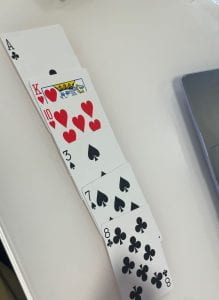 ,if the next player place a card that is either A,K,10,3,7,8- He can take all the cards in between the 2 matched cards.
,if the next player place a card that is either A,K,10,3,7,8- He can take all the cards in between the 2 matched cards.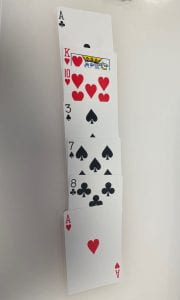 Forexample, this player draws the Ace card from his deck, he wins all the cards between the 2 Aces.
Forexample, this player draws the Ace card from his deck, he wins all the cards between the 2 Aces.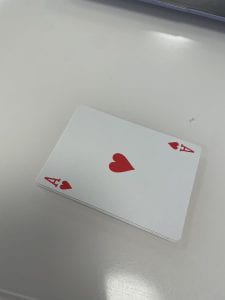 These cards will needs to be shuffled and put it under the winner’s deck
These cards will needs to be shuffled and put it under the winner’s deck